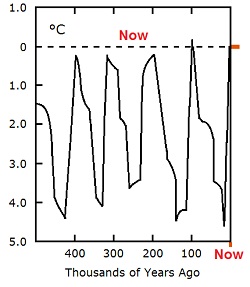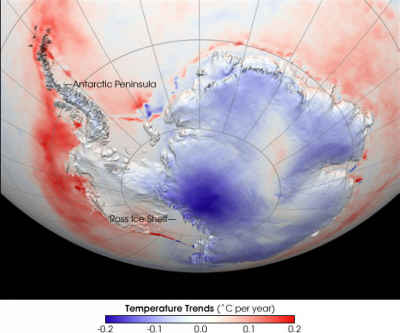|
| Gary Novak
The Cause of Ice Ages and Present Climate |
Technical Context: Sea levels should be stable or slightly decreasing, because increased precipitation is adding snow and ice to the large glaciers on Greenland and Antarctica. The small glacial caps on mountains are too far gone to be of much relevance, though they are melting slightly. Only ice on land melting causes oceans to rise, not ice floating on water. The long term trend is that ocean temperatures continually increase between ice ages due to solar radiation penetrating 10 meters and accumulating. This graph shows ocean temperatures increasing between ice ages, which occur every 100 thousand years.
Official measurements show ocean levels increasing at 3.2 mm per year, which is not much. That's only one foot per century. But even this amount is probably contrived, because true sea level is almost impossible to define or measure. As fake surface temperature measurements show, power mongers in science cannot produce honest measurements without more accountability than exists in climatology. The absence of glaciers melting is a more reliable indicator. The reason why average ocean level is almost impossible to define or measure is because land is constantly moving up and down for numerous reasons, while ocean masses shift even more so. How do you get an average out of it? Contrivers will pick the results they want, as they did for temperature measurements. Oceans drop 400 ft (130 m) during ice ages and rise as the ice melts. So oceans have been rising for the past 20 thousand years. Measurements are showing that over the past few years ocean levels have nearly stopped rising, the reason being that ice is accumulating over central Antarctica due to increased precipitation. But alarmists claim land levels are rising to neutralize ocean levels rising, because glaciers which melted from the previous ice age took weight off the land, which they call "rebound." The fraud of it is that this would have been occurring over 20 thousand years, not just the past few years. Rebound only occurs where the ice was actually located, not every coastline. If it occurred everywhere, sea level would stay the same. Rising relative to what? You have to find land which is not rising to determine that some of it is rising. A determination on January 27, 2010 is 1.5 mm per year of sea level rise, or 6 inches per century. CO2science.org The latest government graph for 2013 says the sea level rise is now 3.2 mm per year, after a decline for a few years. That's only 12.6 inches per century. Media often talk about several feet per century. The reason why sea levels are not significantly rising is increased precipitation due to warming ocean surfaces, which puts more precipitation into the air and more snowfall on ice sheets. The most extreme alarmist publications admit that snowfall is increasing in the center of Antarctica. Frauds made their most recent proclamation, that sea level rise will "only" be one meter over the next century—using models. Models are a fraud. Measurements show it isn't happening. Models are not science. They are used to rationalize fraud. Science is supposed to have the purpose of ending fraud, not promoting fraud. Oceans have been rising an average of 4 ft per century over the past 10,000 years. Now they are rising about 1 ft per century. Oceans rose 2 mm per year during the first half of the 20th century, and only 1.5 mm per year during the second half. Humans are not the cause. Over the past three years, oceans have totally stopped rising, as determined by satellite measurements and published by University of Colorado (shown here). "According to satellite altimetry, which is believed to be considerably more reliable than the tide-gages that it has largely replaced, mean global sea level has been rising by approximately 1 ft (0.3 m) per century during the 16 years since the first satellite began measurements. During the past four years, there has been no statistically-significant sea-level rise at all." Morner and Monckton
Cool-Down Over Land at Antarctica Ice which sits over oceans does not cause a change in sea level when it melts, because the water is already supporting its weight. The only way sea level can rise is when ice which was over land moves into the oceans. Ice which is accumulating on land is lowering the sea level, because it is coming out of the oceans and not flowing back in. The Public Version Vs. the Science Version Global warming propagandists have recently been saying that ocean levels are expected to rise 20 feet in the future. But measurements by tide gauge indicate oceans are rising only 1.8mm per year, which is only 7 inches per century, and ice accumulating over Antarctica will cause sea levels to decrease in the near future. There are two positions propagandists take on every issue: One, there is the public impression. In this case, ice melting everywhere is supposed to tell the public that ocean levels are rising. Two, there is the technical rationalization. Here, the technical rationalization is based upon misrepresented science. Scientific studies show ice accumulating over land on Antarctica and Greenland. Propagandists state the opposite based upon misrepresentation of those studies. The full articles are not available on the internet, but there is enough information to evaluate the claims. The first study was published in Science on May 19 and June 24, 2005. Satellite radar was used to show thickening of ice over eastern Antarctica, with some thinning over western Antarctica, but a net increase, which means slight reducing effect upon ocean levels.
Greenland Study On October 20 and November 11, 2005 Science published a study showing the same thing on Greenland: satellite radar showed ice increasing on the interior of Greenland.
Gravimetric Measurements These results were contradicted by impression based on a new method of measurement by satellites using gravity sensors. In Science, March 2, 2006, a study showed Antarctica losing ice; and in Nature, September 21, 2006, it was reported that Greenland is losing ice. But these later studies describe total size of the ice sheet, which includes ice over the oceans. A reduction in area size only applies to ice over oceans, which does not cause oceans to rise; but this point was not clarified. The gravimetric measurements cannot determine if ice is thickening over land. In other words, gravimetric measurements only determine surface area, which could be done optically. But by using an esoteric method, the public can be misled on the meaning. Washington Post Article Based on Gravimetric Study A Washington Post article describing the gravimetric study of Antarctica said ocean levels would rise, because overland ice was shrinking, which is not what the study showed. In a similar way, it is now common for propagandists to claim ice is shrinking overland on Antarctica. This standard has to be called fraud. Trickery in the way the study was described resulted in false assumptions, and the scientists promoted the false assumptions instead of correcting them. The scientists who did the gravimetric study kept saying ice was shrinking without clarifying that it was ice over water that was shrinking. Then journalists described ice over land as shrinking, while the study had no ability to determine if ice over land was shrinking. The end result is that the gravimetric study is used as the basis for propagandists to falsely claim that ice over land is melting at Antarctica, which will supposedly result in oceans rising. The Washington Post article on the gravimetric study goes so far as to say ice on Antarctica is moving more rapidly toward the oceans as the supposed mechanism for rising ocean levels, since there is no direct melting of ice at Antarctica. The gravimetric study had no ability to determine whether ice was moving. All it could do is locate the boundaries around the ice to determine surface area. Furthermore, if ice were moving more rapidly on Antarctica, the cause would have to be increased weight pushing it faster, while increased weight would require ice to be increasing, not decreasing. Small Effects on Greenland On Greenland, it is said glaciers are moving more rapidly toward the sea due to melt-water lubricating them. But there has been no quantitative determination of the extent to which it is occurring. The anecdotal descriptions appear to apply to coastal areas rather than interior conditions. There does not appear to be much quantitative significance in terms of ocean levels rising, because Greenland is small compared to Antarctica, and only in limited areas is ice moving into the oceans, while satellite radar measurements show ice thickening over land on Greenland. Increased Precipitation Causes Ice to Increase Over Land Ice is increasing over land on Antarctica and Greenland, because precipitation is increasing due to warmer oceans which evaporate more rapidly. This in itself would cause ocean levels to fall. But ocean levels have been slightly rising due to glaciers melting over land. This includes ice falling more rapidly from the sides of Greenland due to warmer ocean water nearby. The amount of ice that can fall off land and into the oceans cannot produce much rise in ocean levels before increasing ice over land causes ocean levels to fall. Highest Ocean Levels It is said that before the last ice age (100,000 years ago), oceans were 20 ft higher than now. This does not mean that the ocean level will be the same height before the upcoming ice age. There is no mechanism which would set the ocean level at any particular height before an ice age. All indications are that the ocean level has peaked and will not get much higher before the next ice age. The reason why the ocean level can be 20 ft lower this time around is because the height is determined by the amount of ice over Antarctica and Greenland. This would be highly variable and would not be the same each cycle. Apparently, more ice has accumulated over Antarctica and Greenland this time around than last time. Glaciers are Irrelevant There are several major frauds in the claim of glaciers melting and causing oceans to rise. Only Greenland and Antarctica have significant ice on them, and they cannot be melting by increased air temperature for the same reason stated above for ice on water. Air does not have sufficient heat capacity. Because of the size of Greenland and Antarctica, the air over them rapidly equilibrates with surroundings. No relevant melting has been observed for Greenland and Antarctica for this reason. Glaciers on mountains can melt, because heated air from valleys below can rise and carry warm air upward. But they have almost all melted away because of it. The small amount left will not create significant rise in ocean level. What melting does occur for them is due to normal temperatures with vertical convection, not global warming. Any temperature will cause such glaciers to melt due to vertical convection. Heavy snowfall will add some back. These effects go back and forth with no relevance to minor changes in average temperature. It takes huge amounts of heat being replaced by convection to melt glaciers, not the 0.6°C which carbon dioxide supposely created but was fake anyway. Such vertical convection cannot occur with Greenland and Antarctica, so they don't melt. Why did Greenland have less ice sometime in the past? Probably because of solar radiation combined with some other effect, such as a volcano dumping ash onto the snow. References: 1. Ice Thickening over Antarctica: Science Abstract: 2. News Story on Same: 3. Ice Thickening over Greenland: Science Abstract: 4. News Story on Same: 5. Gravimetric Measurement over Antarctica. Authors' News Release: 6. Washington Post Article on Same: External Links: Gore Wrong about Antarctica Grounding Line Deep Ocean Heat Scientific Review by CO2 Science Org — indicates 1.5 inches per century Studies by Morner Maldives Propaganda |
|||||||||||||||||||



